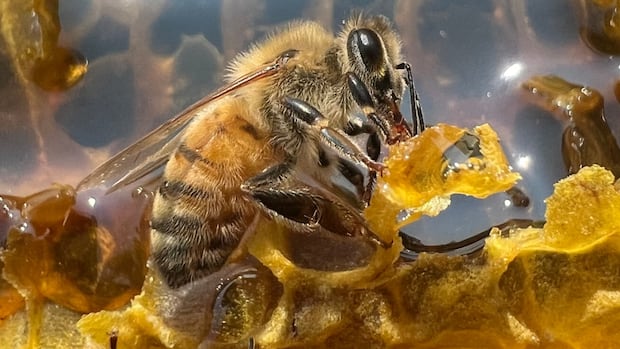These bats copulate for hours with enormous penises but no penetration

Quirks and Quarks8:26These bats copulate for hours with enormous penises but without penetration
Let’s say you saw an animal with long, powerful legs. You might reasonably think it was adapted for running fast. If it had broad, webbed paws, you’d assume it was a proficient swimmer, or if it had sharp, stabbing teeth, that it was a ferocious hunter.
So what if you saw an animal with an impressively long, agile penis?
That’s what Nicolas Fasel saw after receiving an email he initially thought was spam because it came with the word “penis” in its subject. Fasel, a researcher at the University of Lausanne who specializes in bat reproduction, spoke with Quirks & Quarks host Bob McDonald about what happened from there.
First of all, tell me about this email that you clearly clicked on, otherwise we wouldn’t be talking here today. What about it caught your attention?
I received this email [with penis in its title] and first I was thinking, “OK it may be a spam,” but then I thought, “OK, it’s about Eptesicus, which is the Latin name for the species we were studying.” And I thought, “OK, that would be too targeted for spam.”
So I decided to take the risk to open the link and then I found these amazing videos of the copulation of these bats, and we could see that the bats have a very large penis when it’s erect.
OK, so we’re talking about a species of bat here. What species is it?
So it’s called a common serotine. It’s [a] kind of big, big bat, one of the biggest in Europe, in Switzerland. It loves to live in buildings so it’s very, very fond of churches and it loves to eat some big flying beetles.
Now I’m going to read a sentence from your scientific paper. It reads, “With the erect organ seven times longer and wider than the vagina, its possible function becomes a perplexing question.” So tell me about this bat penis.
To observe this penis for the first time, it’s really impressive. You will have this very long and also very wide penis, especially at the terminal part. And the terminal part is really interesting because it has the shape of a heart, but the two lobes in front are quite difficult to imagine penetrating.
How long is it?
So the penis, once it’s erected, it’s 1.6 centimetres, so almost 2 cm and this is quite big. This will represent one-fifth or one-quarter of the bat size.
So besides its size, that heart shape doesn’t sound like it’s designed for penetration.
Exactly, exactly. That was the big question we had, is how can you penetrate anything with this shape.

Well before you embarked on this study, how much did we actually know about how bats copulate?
Oh, very little. So bats normally copulate during very secretive moments, so they can be in caves or in the darkest place of the house, so it’s very difficult to observe any copulation.
And so we were super lucky to have [Dutch citizen scientist and bat enthusiast] Jan Jeucken putting and fitting so many videos inside the church and also having our Ukrainian colleagues who worked with bats in cages and who could witness those copulations.

OK so once you looked at all of these videos, what did you see? Give me a play-by-play of how these bats copulate.
So you will see a female first and then you have this male that will just arrive and try to kind of jump on it on her. So both are crawling and the male will start to bite the nap of the [female’s neck.]
And then once the female is a bit fixed, it will actually go with a very mobile penis around the tail membrane. Once it has found the place, he will push against this vulva and stay there for quite a long time.
How long?
So that was quite a surprise. So we had the median time, so not the average but a bit the middle one, which was at most one hour, but then we had big champions staying in copulation for more than 12 hours.
Twelve hours? Well, what’s the penis doing during all of this time?
So the male penis stays in front of the vulva. Sometimes he’s pressing more or less. And then he’s just staying in contact with the vulva.

In your paper, you describe the bat penis like an arm reaching under the female.
So you have to imagine that the females, like the male, have a tail membrane. So between their legs they have a membrane they can use to cover their lower part. And then you have the male that has to bypass this membrane and use this huge penis as the arm.
On the video, you can clearly see the male moving his penis and moving away the tail membrane in order to reach the vulva.
Sort of like opening curtains to peer on the other side.
Exactly. You got it.
WATCH: Video of serotine bats mating
I guess if it can go on for 12 hours, there must be something in it for her.
Yes, and probably actually, this is the way to test the capacity of the male. If [the] male can stay as long as 12 hours or more, it will be a way for her to say, “OK, this one is really into it and is not just coming and going away.”
But if there’s no penetration involved here, what’s your best guess on how the semen is actually getting into the vagina?
We quite often believe that the male part is just important and that the female genital tract is just a vase with a passive egg that is just floating around and waiting for the spermatozoa. But I guess we forget about all the mechanisms from the female side to actually physically move the spermatozoids toward the fertilization site.
For example, in birds — except in the ostrich maybe — you don’t have a penis. And birds are just touching their cloaca together and the sperm is just transferred from one cloaca to the other and apparently it’s working perfectly fine.

So perhaps it’s like a sort of an internal pump within the female that can draw the semen in?
I think more than possibly, yeah. The female genital tract is known to move the sperms toward the fertilization sites.
So putting all of this together, what insight does this give you about where bats fit in when it comes to the evolution of copulation?
We know already that bats are very different, very unique. They live super long in terms of immunity, they have lots of diseases and viruses, but they do perfectly fine. So there are many aspects that are quite unique and I guess with reproduction we also have something that is quite amazing. So for example, it’s known that bats have the possibility to store sperm for several months. They can delay ovulation. They can delay the implantation or the embryonic development. So yeah, they are really unique in many aspects and apparently in copulation, they are also quite, quite strange.
Interview has been edited for length and clarity.





